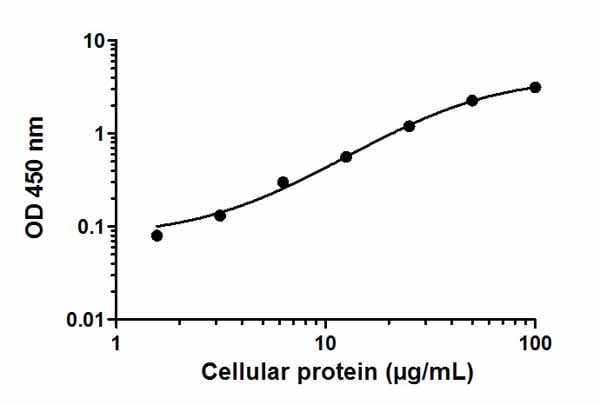ERK1/2 (pT202/Y204) ELISA Kit (ab176640)
Key features and details
- One-wash 90 minute protocol
- Sensitivity: 0.1 ng/ml
- Range: 0.2 ng/ml - 20 ng/ml
- Sample type: Cell Lysate, Tissue Homogenate
- Detection method: Colorimetric
- Assay type: Semi-quantitative
- Reacts with: Mouse, Human
Overview
-
Product name
ERK1/2 (pT202/Y204) ELISA Kit
See all ERK1 + ERK2 kits -
Detection method
Colorimetric -
Precision
Intra-assay Sample n Mean SD CV% A431 extract 6 3.3% Inter-assay Sample n Mean SD CV% A431 extract 3 1.3% -
Sample type
Cell Lysate, Tissue Homogenate -
Assay type
Semi-quantitative -
Sensitivity
0.1 ng/ml -
Range
0.2 ng/ml - 20 ng/ml -
Assay time
1h 30m -
Assay duration
One step assay -
Species reactivity
Reacts with: Mouse, Human
Predicted to work with: Rat
-
Product overview
ERK1/2 (pT202/Y204) in vitro SimpleStep ELISA™ (Enzyme-Linked Immunosorbent Assay) kit is designed for the semi-quantitative measurement of ERK1/2 (pT202/Y204) protein in Human and mouse cells.
The SimpleStep ELISA™ employs an affinity tag labeled capture antibody and a reporter conjugated detector antibody which immunocapture the sample analyte in solution. This entire complex (capture antibody/analyte/detector antibody) is in turn immobilized via immunoaffinity of an anti-tag antibody coating the well. To perform the assay, samples or standards are added to the wells, followed by the antibody mix. After incubation, the wells are washed to remove unbound material. TMB substrate is added and during incubation is catalyzed by HRP, generating blue coloration. This reaction is then stopped by addition of Stop Solution completing any color change from blue to yellow. Signal is generated proportionally to the amount of bound analyte and the intensity is measured at 450 nm. Optionally, instead of the endpoint reading, development of TMB can be recorded kinetically at 600 nm.
As of October 2019, this kit was reformulated with new antibodies to maintain continued long term supply.
-
Notes
Abcam has not and does not intend to apply for the REACH Authorisation of customers’ uses of products that contain European Authorisation list (Annex XIV) substances.
It is the responsibility of our customers to check the necessity of application of REACH Authorisation, and any other relevant authorisations, for their intended uses. -
Platform
Microplate
Properties
-
Storage instructions
Store at +4°C. Please refer to protocols. -
Components 1 x 96 tests 10X Wash Buffer PT 1 x 15ml 50X Cell Extraction Enhancer Solution 1 x 1ml 5X Cell Extraction Buffer PTR 1 x 12ml ERK1/2 (pT202/Y204) Capture Antibody 1 x 3ml ERK1/2 (pT202/Y204) Detector Antibody 1 x 3ml Lyophilized ERK1/2 Control Lysate 1 vial Plate Seal 1 unit SimpleStep Pre-Coated 96-Well Microplate (ab206978) 1 unit Stop Solution 1 x 12ml TMB Substrate 1 x 12ml -
Research areas
-
Function
Involved in both the initiation and regulation of meiosis, mitosis, and postmitotic functions in differentiated cells by phosphorylating a number of transcription factors such as ELK1. Phosphorylates EIF4EBP1; required for initiation of translation. Phosphorylates microtubule-associated protein 2 (MAP2). Phosphorylates SPZ1 (By similarity). Phosphorylates heat shock factor protein 4 (HSF4) and ARHGEF2.
Acts as a transcriptional repressor. Binds to a [GC]AAA[GC] consensus sequence. Repress the expression of interferon gamma-induced genes. Seems to bind to the promoter of CCL5, DMP1, IFIH1, IFITM1, IRF7, IRF9, LAMP3, OAS1, OAS2, OAS3 and STAT1. Transcriptional activity is independent of kinase activity. -
Sequence similarities
Belongs to the protein kinase superfamily. CMGC Ser/Thr protein kinase family. MAP kinase subfamily.
Contains 1 protein kinase domain. -
Domain
The TXY motif contains the threonine and tyrosine residues whose phosphorylation activates the MAP kinases. -
Post-translational
modificationsDually phosphorylated on Thr-185 and Tyr-187, which activates the enzyme. Dephosphorylated by PTPRJ at Tyr-187. -
Cellular localization
Nucleus. - Information by UniProt
-
Alternative names
- ERK 1
- ERK 2
- ERK-1
see all -
Database links
- Entrez Gene: 5595 Human
- Entrez Gene: 5594 Human
- Entrez Gene: 26417 Mouse
- Entrez Gene: 26413 Mouse
- Entrez Gene: 50689 Rat
- Entrez Gene: 116590 Rat
- Omim: 601795 Human
- Omim: 176948 Human
see all
Images
-
SimpleStep ELISA technology allows the formation of the antibody-antigen complex in one single step, reducing assay time to 90 minutes. Add samples or standards and antibody mix to wells all at once, incubate, wash, and add your final substrate. See protocol for a detailed step-by-step guide.
-
Example of a typical ERK1/2 (pT202/Y204) cell lysate dilution series. Background-subtracted data values (mean +/- SD) are graphed.
-
Example of a typical ERK1/2 (pT202/Y204) recombinant protein standard curve. The proportion of total protein that is phosphorylated is unknown - data is indicative only. Background-subtracted data values (mean +/- SD) are graphed.
-
Linearity of dilution in representative sample matrices. Cellular lysates were prepared at 3 concentrations in common media containing 1X Cell Extraction Buffer PTR. Data from duplicate measurements of ERK1/2 (pT202/Y204) are normalized and plotted.
-
Cell line analysis for Total ERK1/2 from 100 µg/mL preparations of cell extracts. Data from triplicate measurements (mean +/- SD) are plotted and compared to 1X Cell Extraction Buffer PTR (zero).
-
Induction of ERK1/2 (pT202/Y204) phosphorylation in MCF-7 cells in response to EGF treatment. MCF-7 cells were cultured in 96-well tissue culture plates, serum starved and treated (10 min) with a dose-range of EGF before cell lysis. Data from quadruplicate measurements of ERK1/2 (pT202/Y204) are plotted and compared against Total ERK1/2 protein levels. Comparative ERK1/2 (pT202/Y204) and ERK1/2 (Total) data also shown by Western Blot.


















